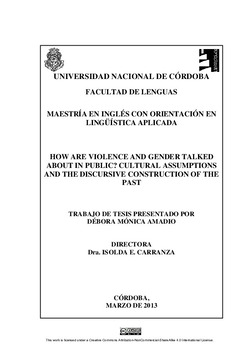| dc.contributor.advisor | Carranza, Isolda E. | |
| dc.contributor.author | Amadio, Débora Mónica | |
| dc.date.accessioned | 2022-09-26T18:43:29Z | |
| dc.date.available | 2022-09-26T18:43:29Z | |
| dc.date.issued | 2013 | |
| dc.identifier.uri | http://hdl.handle.net/11086/28614 | |
| dc.description | Maestría en Inglés con orientación en Lingüística aplicada | |
| dc.description.abstract | From the theoretical perspective of situated discourse analysis and drawing on the
related research traditions of critical discourse analysis and conversation analysis, this
study examines the discursive construction of interested versions of the past in the
context of lay witness examinations. The view of discourse advocated acknowledges its
socially constructed nature, and understands it as a complex configuration of semiotic
resources. The corpus analyzed is made up of a linguistic subcorpus of twelve lay
witness examinations and a multimodal subcorpus of 101 video clips featuring extracts
from interactions between lay witnesses and litigants. The analysis reveals that litigants
deploy interactional mechanisms that guarantee the generation of implications favorable
for the version of the past upheld. One of the mechanisms identified includes the use of
questions about the meaning of everyday expressions. The other consists in combining
questions about specific past behaviors with those that invoke mental representations
stored in situation models. This study also includes an exploration of different speechaccompanying gestures that cooccur with a specific kind of propositional content. It is
shown that lay witnesses’ use of hand movements combined with facial expressions and
head shakes is related to the type of cognitive activity performed and the kind of
information requested in the question. The examination of the recurrent interactional
routines initiated by litigants indicates that institutional participants resort to
mechanisms through which they guide their interlocutors into verbalizing content aimed
at generating implications that are damaging to the positive face of parties involved in
the conflict. The analysis reveals that, in the examinations observed, what gets
systematically evaluated is witnesses’ past sexualized conduct. This suggests that
witness credibility can be attacked by alluding to the dimension of morality. This study
concludes by unveiling the cultural assumptions and values about sexualized practices
that permit that covert evaluations be generated. | es |
| dc.language.iso | eng | es |
| dc.rights | Atribución-NoComercial-CompartirIgual 4.0 Internacional | * |
| dc.rights.uri | http://creativecommons.org/licenses/by-nc-sa/4.0/ | * |
| dc.subject | Lingüística aplicada | es |
| dc.subject | Estudios de discurso | es |
| dc.subject | Discursive construction | es |
| dc.subject | Face-to-face interaction | es |
| dc.subject | Gender | es |
| dc.subject | Morality | es |
| dc.title | How are violence and gender talked about in public? : cultural assumptions and the discursive construction of the past | es |
| dc.type | masterThesis | es |
| dc.description.fil | Fil: Amadio, Débora Mónica. Universidad Nacional de Córdoba. Facultad de Lenguas; Argentina. | es |





